Jul 30, 2019
Museums in Kochi City, Shikoku: Celebrating region’s stellar cultural exports
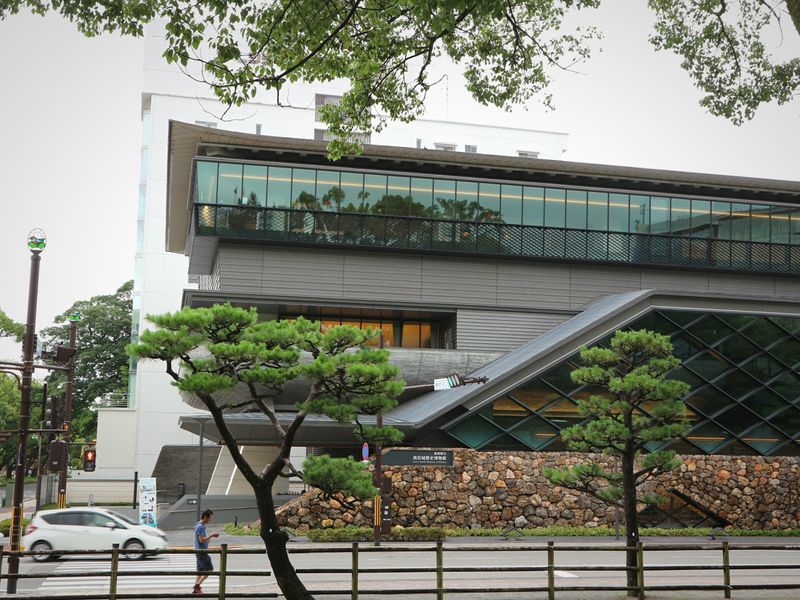
On a Saturday in mid-July above the city of Kochi, on Japan’s island of Shikoku, ominous rain clouds loomed dark and heavy with local forecasters having issued warnings about the potential for flooding the previous night. Not a great day to get out and explore outside of the city then. Instead we set about visiting the museums in Kochi which cover, among others, the city and the region’s most famous cultural exports -- Sakamoto Ryoma, manga, and Yosakoi.
Apart from taking one of Kochi’s grinding, screeching trams between Kochi Station and the city’s central hub of Harimayabashi we made our way around all of these museums in Kochi on foot, something which took us the bulk of the day (approx. 10am to 4pm) and left us feeling sweaty, tired but ultimately rewarded.
Starting out from a hotel a stone’s throw from Kochi’s Harimayabashi we headed west along the covered arcade of Obiyamachi before exposing ourselves to the threat of rain along the broad Ohashi-dori -- one of Kochi City’s main east-west thoroughfares. It took us 20 - 30 minutes to reach the first of our museums in Kochi, Ryoma’s Birthplace Memorial Museum.
Ryoma’s Birthplace Memorial Museum
There are nods to, and celebrations of, Kochi’s favorite son, the Meiji-era reformer Sakamoto Ryoma, throughout the city of Kochi.
In the Kamimachi district southwest of Kochi Castle Ryoma fans can take their understanding of the man back to a grassroots level at the Kochi Municipal Ryoma’s Birthplace Memorial Museum.
This relatively compact Kochi museum makes use of two floors to provide visitors with an insight into Ryoma’s formative years and the motions of daily life that helped shaped him into one of Japan’s key reformers.
At the reception of Ryoma’s Birthplace Memorial Museum visitors can get their hands on the rather nifty “pendoku” multilingual guide. This consists of a touch-pen device, headphones and laminated map of the facility. Tap the pen on relevant points of the laminated map to activate explanations. It’s a little cumbersome to carry around but you’ve got to appreciate the effort on the part of museum organizers.
The exhibits kick-off with a welcome from Ryoma himself -- a painting of Ryoma as a boy that (audibly) greets visitors in the Tosa dialect. The painting is a creation of award-winning artist Yutaka Murakami.
From here the museum launches into large-scale models of the Kamimachi district of Kochi where Ryoma grew up. A wonderfully drawn timeline (again featuring paintings from Murakami) takes us from Ryoma’s birth (born with hair on his back according to legend) through the appearance of Commodore Perry’s black ships that saw Tokugawa Japan break out in a clammy sweat and triggered the process of political reform in which Ryoma played such a key role.
The “Tunnel of Time” feels a little unnecessary, linking visitors to an annex by way of a corridor fitted with a light and sound show that doesn’t really fit the mood. Still, once at the annex, museum visitors can get a look at a recreation of Ryoma’s home annex.
On the second floor visitors will find a scale model of Edo-era Kamimachi and there is a video room scrolling regular screenings of “The Ryoma Experience” charting our reformers childhood through to his escape from the Tosa region (in those days you had have permission, you see).
Perhaps the most visually striking feature of the Ryoma’s Birthplace Memorial Museum is the statue of Ryoma installed in the facility’s courtyard. The statue is a life-size recreation of Ryoma based on what is said to be the last photograph taken of the man, in the autumn of 1867. Ryoma was assassinated in December that year.
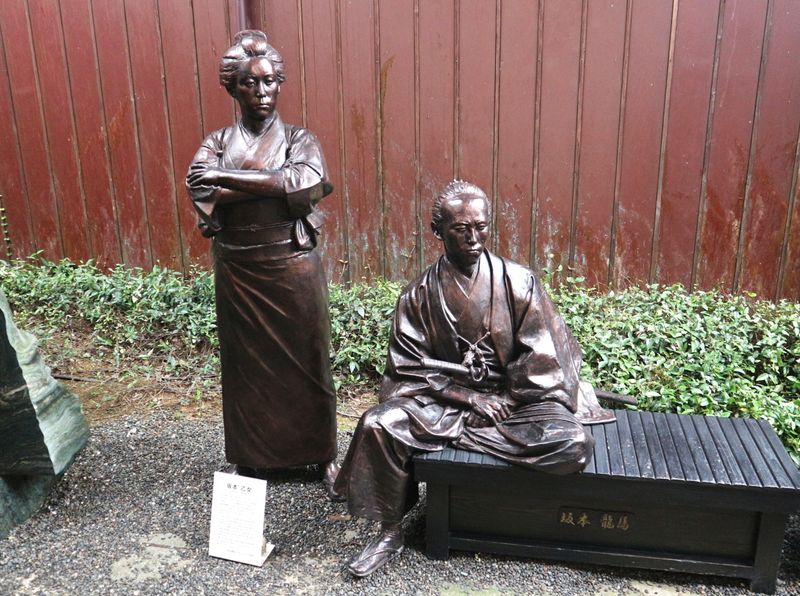
Ryoma’s Birthplace Memorial Museum is small but earnest and full of charm. For an introduction to the Ryoma basics it appears to do a sterling job. Give it an hour. A light English-language pamphlet is available which has space for your Ryoma stamp!
| Entrance | 300 yen (High school students and under get in free) |
| Hours | 8:00 - 19:00 |
| Open | All-year-round |
| Web | https://ryoma-hometown.com/en |
| Access | Nearest tram stop, Kamimachi 1-Chome. 3-minute walk from here. |
Back on Ohashi-dori to backtrack towards town before taking a left at tram stop Kochijo-Mae from which it’s a short walk to the castle and the next stop on our walk around the museums in Kochi, the Kochi Castle Museum of History.
Kochi Castle Museum of History
The Kochi Castle Museum of History is an impressive facility occupying a prime bit of Kochi real estate across the waters of Kochi Castle’s moat, near to the castle’s main gate. In fact, the view to the castle keep from the museum’s third-floor Kochi Castle Outlook Lobby might be worth the entrance fee on its own. At the very least, it’s an impressive place to chill.
The focus of the Kochi Castle Museum of History centers on the Yamauchi clan -- the family that ruled over the then Tosa Province from the 17th to the 19th century. (The museum is produced by the Yamauchi Family Treasury and Archives.)
Museum exhibits are displayed on the facility’s third floor, and this is the bit you need to pay for.
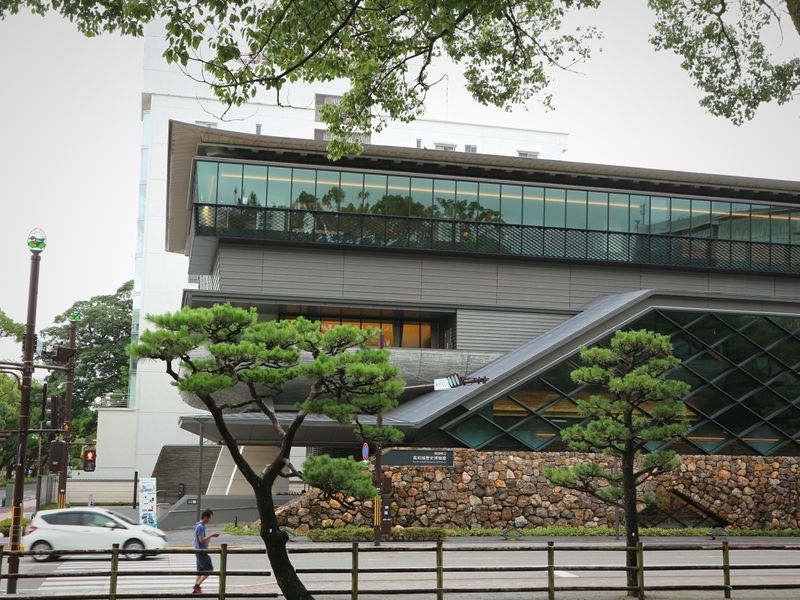
With over 67,000 historical documents at their disposal, museum management would appear to have the power to overwhelm. Things get off to a sensible start though courtesy of a collection of video displays where visitors can don headphones and get the basics of the castle’s history (replete with insights into its construction and innovative defenses), background of the Yamauchi family and treasures to look out for within the museum.
From there museum visitors are taken through an introductory exhibit detailing the chronology of the Tosa Domain before being lead into the general exhibition rooms that showcase items from the Sengoku and Edo periods.
There are a lot of documents on show at the Kochi Castle Museum of History (museum curators have over 30,000 at their disposal) including important land registers. Valuable historical resources, no doubt, but such displays leaves those who aren’t literate in Japanese feeling a little cold.
More accessible to these foreign eyes were the pair of tachi swords from the 14th century, a set of armor worn by the second of the Yamauchi lords, Yamauchi Tadayoshi and a distinctive battle helmet designed in the shape of a rabbit belonging to Yamauchi Toyomasa the fourth of the Edo-era Tosa lords.
After taking in the exhibits kick back in the Kochi Castle Outlook Lobby for a prime view over the castle’s Otemon Gate and beyond to the keep. (The museum’s cafe on the second floor has similar views.)
Taking the stairs down to the first floor might be the best way to take in the museum’s interior design and traditional architecture, giving you a good look at the walls made from Tosa cypress.
Kochi Castle Museum of History is a beautiful facility (both inside and out) and the views to castle are impressive. However, without a deep understanding of Japanese some may feel the exhibits on display can be covered all too quickly.
| Entrance | 500 yen when only permanent exhibits available / 700 yen during special periodic exhibits (children of high school age or younger get in free, as well as others) |
| Hours | 9:00 - 18:00 |
| Open | Closed Dec. 26 - 31, 2019 |
| Web | https://www.kochi-johaku.jp/en/ |
| Access | 3 minutes on foot from Kochijomae tram stop |
From the Kochi Castle Museum of History we take a road heading north off of the busy Ote-suji through an area of schools and educational institutions before crossing the Enokuchi River and making a quick left into quiet residential lane on which is No. 3 of our museums in Kochi.
Okawa-suji Samurai Residence Museum
This small former home-cum-museum that sits on a sleepy street just north of the Enokuchigawa River is landmark No. 2 on The Historical Trail that navigates its way around central Kochi.
The property is easily spotted for it’s impressive reproduction of the original building’s 19th century gatehouse that sits immediately street side.
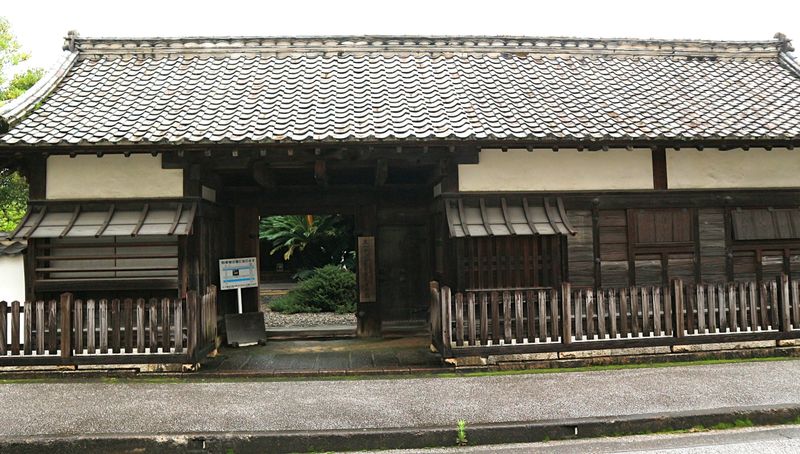
English-language signage outside gives the basic details of the property which is the “only samurai residence left in the castle town of Kochi City.”
The house had been left to ruin for a while before a collective of local volunteers initiated the first steps of a movement towards preservation which resulted in the local government naming the property a material cultural asset, thus initiating restoration work.
Information, for English-speakers at least, is spartan but the chances are you’ll have the Okawa-suji Samurai Residence Museum to yourself, without so much as a member of staff in sight. It’s fun then, to poke around the various rooms of the property, which have some simple furnishings, fixtures and fittings in place, basking in the quiet and the samurai atmosphere. A large cycad tree between the gatehouse and main building brings an air of faded tropical glory to your explorations.
| Entrance | Free |
| Hours | 9:00 - 17:00 |
| Open | Closed Dec. 27, 2019 - Jan. 3, 2020 |
| Access | 15 minutes on foot from Kochi Castle Museum of History |
We head east along the quiet lane until we reach the retro signage of the busy Atago-dori Avenue using this to hit the large thoroughfare that speeds between the post office and Kochi Police Station to reach the south side of Kochi Station.
Kochi Prefecture “i” Information Center & Ryomaden Bakumatsu Heroes Pavilion
Perhaps stretching it as a Kochi museum, the Kochi Tourist Information Center, just outside Kochi Station’s south exit, is nonetheless a fantastic resource. There’s bucket loads of information available here, including that which can be delivered from staff who speak English, in the form of pamphlets and maps covering all things Kochi and beyond.
Behind the information section of the center is the requisite souvenir shop but the star of the show, in more ways than one, is the Ryomaden Bakumatsu Heroes Pavilion.
At the Ryomaden Bakumatsu Heroes Pavilion visitors can stroll through sets used in the TV series “Ryomaden,” NHK’s 49th Taiga drama which aired in 2010 and centered on the lives’ of Sakamoto Ryoma and the industrialist Iwasaki Yataro.

There’s almost nothing here written in English but it’s still fun to have a look around (take off your shoes) and settle down on one of the many zabuton and stare out at the faux garden. There’s also a bit of a photo corner where you can have your mugshot taken in “Ryoma’s room,” should you have someone with you willing to operate the camera.
| Entrance | Free |
| Hours | 9:00 - 17:00 |
| Open | All-year-round (?) |
| Access | Stone’s throw from the South Exit of Kochi Station |
A Ryoma latte from a cafe in the train station isn’t sustenance enough to motivate the legs for the walk down Hariyama Street so we take a tram to Harimayabashi instead. From the tram stop it’s just a short stroll through the covered Harimayabashi Shotengai at the end of which is surely the most colorful of the museums in Kochi.
Kochi Yosakoi Museum
Bright, bold and colorful, Kochi Yosakoi Museum appears all about the visuals as it gives a light and fun introduction to the history of the Yosakoi Festival which first broke out into dance in Kochi in 1954 -- a creation of the city’s Chamber of Commerce and Industry to inject a bit of fiscal stimulus and fun into the city during the post-war years.
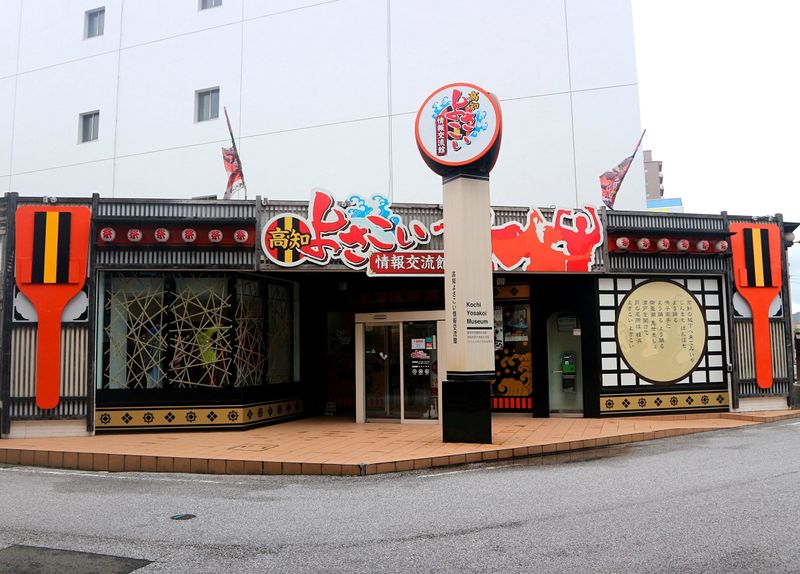
The museum breaks things down into two areas -- the Yosakoi Circle and the Yosakoi Square.
Starting with the Yosakoi Circle, visitors to the facility are given the basics in yosakoi history as well as the rules of the song and dance contest -- keep moving forward at all times, must use the phrase “Yosakoi naruko-odori” in the song … .
It’s here in the “circle” that you can seen grainy black and white footage of the very first Yosakoi Festival, about the only display in the museum that isn’t delivered in a blaze of color.
This section of the museum also gives time and space to explanations of the Yosakoi Festival’s six core factors -- costumes, dance, music, jikatasha trucks, naruko clappers and medals. Take time to listen to the original Yosakoi song, “Yosakoi Naruko Odori” penned by Eisaku Takemasa.
Moving between “circle” and “square” it’s fun to ogle posters for each of the Yosakoi events over the years.
In the Yosakoi Square visitors can see examples of the brilliant costumes that teams of the years have stitched together (feel free to take photos). There’s also a space where you can learn the basics of Yosakoi dance moves courtesy of a fun video (naruko clappers are available).
What English-language explanation there is here is delivered via laminated A4 sheets stuck to the walls. They look a little incongruous compared to the carefully designed Japanese displays but the effort is appreciated.
Outside the Yosakoi Circle section of the museum though, the visuals of costumes, posters and dance videos deliver satisfaction enough, especially when you consider you’ve not paid anything to get in.
| Entrance | Free |
| Hours | 10:00 - 18:30 |
| Open | Closed Wednesdays, Dec. 29 - Jan. 1 |
| Web | http://www.honke-yosakoi.jp/ |
| Access | Eastern end of Harimayabashi Shopping Street (Shotengai) |
The last of the museums in Kochi we had intended to visit is a short walk from the Kochi Yosakoi Museum, the other side of Ohashi-dori next to the Harimayabashi Kankou Bus Terminal.
Yokoyama Memorial Manga Museum
Kochi Prefecture seems an unlikely place to have given birth to so much talent from the world of manga, being so far removed from Japan’s major creative hubs, but there can be no doubting the area’s pride in this.
Takashi Yanase, the creator of Anpanman, hailed from these parts -- the Kami City Takashi Yanase Memorial Hall & Anpanman Museum can be found in Yanase’s place of birth around 20km northeast of Kochi City, and there are statues of characters from the anime dotted throughout the downtown Kochi area. Kochi is also host to the annual Kochi Manga Festival “Mansai,” the Mangaka Daikaigi -- a conference of manga artists from around Japan -- and the National High School Manga Championship “Manga Koshien.”
Visitors to Kochi don’t have to leave the city, though to celebrate another of the region’s manga heroes.

The Yokoyama Memorial Manga Museum is just a short walk east of Harimayabashi, on the third floor of Kochi City Culture-Plaza Cul-Port.
Ryuichi Yokoyama (1909 - 2001) was born in Kochi city but spent much of the latter years of his life in Kanagawa Prefecture, near Tokyo. Yokohama was made an Honorary Citizen of Kochi City in 1996 two years after becoming the first manga artist in Japan to be recognized as a “person of cultural merit.”
The colorful and charming Yokoyama Memorial Manga Museum was opened in 2002, less than one year after Yokoyama’s passing.
Immediately after entering the museum visitors are welcomed by a statue of Fuku-chan, the 5 / 6-year-old-boy who went on to become Yokohama’s most celebrated character. (If you shake Fuku-chan’s hand, he’ll say, “Hi.”.)
Much of the museum’s third-floor entrance is given over to a library. At the information counter though English-language museum maps / pamphlets are available and at the Tosa: The Manga Kingdom section you can get an eye-full of the kind of talent that the Kochi region seems to have on tap.
A broad staircase leads up to the fourth floor. At the top of the staircase be sure to turn round and ogle the large Gyo-Gyo Tower -- handing art in the form of a giant fish created by Yokoyama himself.
To guide us around the bulk of the exhibits on the museum’s fourth floor we downloaded the free Museum Exhibition Guide Application to our smartphone, which covers the Yokoyama Memorial Manga Museum.
The colorful and playful exhibits here are largely displayed in chronological order, kicking things off with My Playful Life, in which works from the Yokohama’s youth are on display, before moving onto his post-school years and then to the formation of the Manga Faction Society in 1932.
Fuku-chan Lane introduces Yokohama’s most celebrated character, framing the energetic child against the background of a war, from which Yokohama’s creation offered the nation some respite. Puzzles and peepholes make this a great area for kids.
Yokohama went on to establish the production company Otogi Pro in order that he might be able to make his own anime productions. An exhibit at the museum screens some of the resulting works.
From here the displays become more personal, giving an insight into the charming child that appears to have remained within Yokoyama. Particularly delightful is the huge Ryuichi Gara Gara -- a mad train set on which carriages travel through a ramshackle collection of trinkets and oddities. The set comes to life as you make your approach.
A little more adult, though no less charming, is Home Bar “Gura,” a replica of the bar that Yokohama created in his home in Kanagawa Prefecture. An audio recording of Yokohama adds to the atmosphere.
Even those who have scant interest in manga and anime will find it hard not to be charmed by Yokoyama Memorial Manga Museum which, for the layman, offers an experience akin to poking around the home of a much-loved, well-traveled, but slightly eccentric grandparent.
Kochi City Culture-Plaza Cul-Port is a huge building that is almost impossible to miss on the approach. At the time of visiting though, signs for the Yokoyama Memorial Manga Museum were difficult to spot at ground level so take the plunge and head straight for the third floor courtesy of the open-air escalators.
Despite the size of Kochi City Culture-Plaza Cul-Port, there’s little else to keep visitors here.
| Entrance | 410 yen |
| Hours | 9:00 - 18:00 |
| Open | Closed Mondays, Dec. 28 - Jan. 4 |
| Web | http://www.bunkaplaza.or.jp/mangakan/english/index.html |
| Access | 5 minutes on foot from Harimayabashi |
Have you been to any of the above museums in Kochi City? Any other of Kochi’s museums that you would like to see on this list? Let us know in the comments.



0 Comments